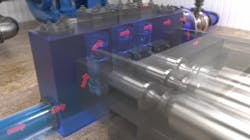CPS Energy, Quidnet Energy to Build Grid-Scale, Geomechanical Pumped Storage Project
CPS Energy and Quidnet Energy signed a 15-year commercial agreement for an energy storage project employing Quidnet’s Geomechanical Pumped Storage (GPS) technology.
This project will support CPS Energy’s ‘Flexible Path’ Resource Plan to reduce net emissions by 80 percent by 2040. Energy storage is a key part of that plan, with long-duration systems like Quidnet’s GPS expected to play an increasingly critical role.
The project will be developed in two phases, starting with an initial one-MW, 10-hour storage facility. CPS Energy has partnered with Quidnet under a 15-year agreement that will allow time for both parties to explore this type of technology. CPS Energy will have the option to expand the project to provide 15 MW as the project matures.
EPIcenter’s Innovation Management program was engaged to support CPS Energy’s decision-making process for this novel form of energy storage. The program facilitates the process alongside a curated council of CPS Energy leadership to vet and implement emerging technologies.
“Incorporating Quidnet’s homegrown-Texan energy storage solution allows us to create a cleaner electric supply while supporting our local energy industry workforce and lowering costs for our customers,” said CPS Energy Interim President & CEO Rudy Garza.
“Quidnet is excited to partner with an industry leader like CPS Energy and is grateful for EPIcenter’s support in achieving this important commercial milestone for the energy storage industry,” said Joe Zhou, Quidnet CEO. “Just a few years ago, almost no one was talking about long-duration energy storage. Today, it’s one of the fastest growing areas of the energy sector. CPS Energy is leading the way with this breakthrough project.”
Quidnet’s GPS energy storage technology pumps water underground and stores it between impermeable rock layers. The rock performs like a natural spring and holds the water under pressure. When the project is called upon to supply electricity, the pressurized water is released to power a hydroelectric turbine that generates emission-free electricity. The entire process is closed loop to conserve water resources.
Quidnet projects employ much of the same expertise, workforce, and supply chains as the oil and gas industry. Its development provides a pathway into the green economy for O&G professionals.
The technology is a form of pumped hydro storage, which currently provides over 90 percent of the world’s energy storage capacity, but deployable in a wide and diverse swath of geographies previously considered unsuitable for pumped hydro development. This unique approach to energy storage offers a new, cost-effective, highly scalable tool that is key to unlocking the global clean energy future.
Previously, Quidnet developed Texas energy storage test sites in Medina and San Saba Counties. It is working on pilot projects in Ohio, New York, and Alberta, Canada. The company is backed by Breakthrough Energy Ventures, Evok Innovations, Trafigura, and other investors and has received support from the U.S. Department of Energy, the New York State Energy Research and Development Authority, and Emissions Reduction Alberta.
